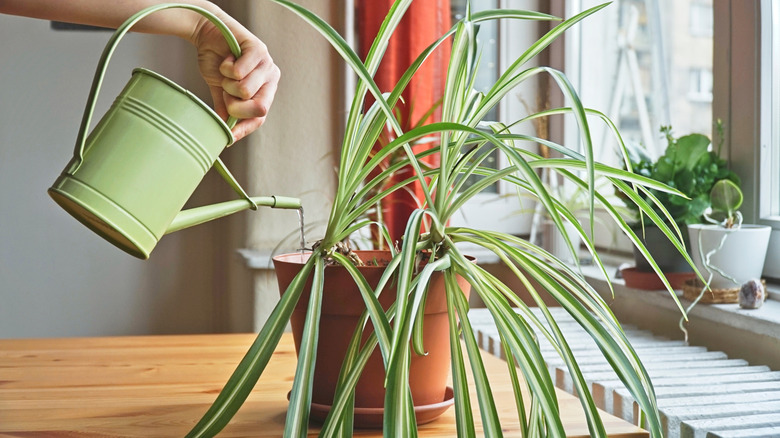How To Keep This Popular Houseplant Thriving Throughout The Winter
Houseplants are a great way to add beauty and life to your home, especially during dreary winter months. There is even evidence that they can lower your stress levels. One of the most popular is the charming and low-maintenance spider plant (Chlorophytum comosum). While this beauty is easy to care for, you do need to take a few extra steps to keep it thriving through the winter months. This includes keeping it in a warm place, watering it less, and avoiding overfertilizing.
Spider plants are native to tropical parts of West Africa and are only hardy in USDA Hardiness Zones 9 and higher. Therefore, if yours spent the summer outside, it's important to bring it back indoors before temperatures start to drop too low. Take some time to let it reacclimate to indoor conditions, and check to be sure it isn't bringing any pests in with it.
While it's true that spider plants can grow without a ton of natural light, they may still need some time to adjust to that if they've previously been planted outdoors. They grow best with bright but indirect lighting. Try to find your plant a winter home where it won't be exposed to cold drafts from windows and the temperature stays between 65 degrees and 75 degrees Fahrenheit. Spider plants are also fond of medium humidity, making them good houseplants for the bathroom. If you are growing your spider plant in a spot with especially low humidity, you may want to place a tray covered with pebbles and an inch or two of water under it to boost the moisture in the air.
How to care for your spider plant during cold winter months
While it's still important to care for your spider plant during the winter months, you can easily love it to death. It generally requires far less water during this time of year compared to summer. Make sure you wait for the potting soil to dry out a little before you water, or you may be setting your plant up to suffer from root rot. While you may be able to fix root rot, it's best to prevent it entirely. Spider plants are happiest when they are watered with distilled water instead of tap water. Keep an eye out for browning on the tips of the leaves. This can be a sign that your spider plant is either over- or under-watered. Excessive fertilizing and low humidity can also be culprits.
Spider plants, like many tropical houseplants, aren't in their active growing phase during the winter months. This means that in addition to less water during this time, they also need less fertilizer. While you should be fertilizing about once a month during spring and summer, you should skip this step entirely during fall and winter.
If your spider plant is beginning to outgrow its pot, you can safely repot it at any time of year, including winter. Late winter is generally the best time for moving your plant to a bigger container, though. Repotting plants encourages them to get growing again, so late winter capitalizes on the change in season to gradually receive more light. You should still hold off on fertilizing for several months after repotting.

